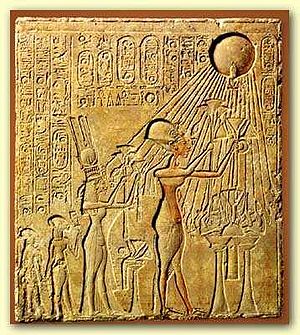Aten
- Alternative use: the Aten asteroids, named after 2062 Aten

| Aten in hieroglyphs |
|---|
| [1] |
Aten (also Aton, Egyptian jtn) the disk of the sun in ancient Egyptian mythology, and originally an aspect of Ra. He became the focused upon deity of the arguably monolatristic, henotheistic, or even monistic religion of Atenism of which Amenhotep IV established, who later took the name Akhenaten in worship and recognition of Aten. The worship of Aten seemed to stop shortly after Akhenaten's death. In his poem "Hymn to Aten," Akhenaten praises Aten as the creator, and giver of life.
Contents |
Overview
The full title of Akhenaten's god was The Rahorus who rejoices in the horizon, in his/her Name of the Light which is seen in the sun disc. (This is the title of the god as it appears on the numerous stelae which were placed to mark the boundaries of Akhenaten's new capital at Akhetaten, modern Amarna.) This lengthy name was often shortened to Ra-Horus-Aten or just Aten in many texts, but the god of Akhenaten raised to supremacy is considered a synthesis of very ancient gods viewed in a new and different way.

Both Ra and Horus characteristics are part of the god, but the god is also considered to be both masculine and feminine simultaneously. All creation was thought to emanate from the god and to exist within the god. In particular, the god was not depicted in anthropomorphic (human) form, but as rays of light extending from the sun's disk. Furthermore, the god's name came to be written within a cartouche, along with the titles normally given to a Pharaoh, another break with ancient tradition.

The Aten, the sun-disk, first appears in texts dating to the 12th dynasty, in The Story of Sinuhe, where the deceased king is described as rising as god to the heavens and uniting with the sun-disk, the divine body merging with its maker.[2]
Ra-Horus, more usually referred to as Ra-Herakhty (Ra, who is Horus of the two horizons), is a synthesis of two other gods, both of which are attested from very early on. During the Amarna period, this synthesis was seen as the invisible source of energy of the sun god, of which the visible manifestation was the Aten, the solar disk. Thus Ra-Horus-Aten was a development of old ideas which came gradually. The real change, as some see it, was the apparent abandonment of all other gods, above all Amun, and the debatable introduction of monotheism by Akhenaten.[3] The syncretism is readily apparent in the Great Hymn to the Aten in which Re-Herakhty, Shu and Aten are merged into the creator god.[4] Others see Akhenaten as a practitioner of an Aten monolatry,[5] as he did not actively deny the existence of other gods; he simply refrained from worshipping any but the Aten.
Royal Titulary
During the Amarna Period, the Aten was given a Royal Titulary (as he was considered to be king of all), with his names drawn in a cartouche. There were two forms of this title, the first had the names of other gods, and the second later one which was more 'singular' and referred only to the Aten himself. The early form has Re-Horakhti who rejoices in the Horizon, in his name Shu which is the Aten. The later form has Re, ruler of the two horizons who rejoices in the Horizon, in his name of light which is the Aten.

Variant translations
- Because high relief and low relief illustrations of the Aten show it with a curved surface (see for example the photograph illustrating this article), the late scholar Hugh Nibley insisted that a more correct translation would be globe, orb or sphere, rather than disk. The three-dimensional spherical shape of the Aten is even more evident when such reliefs are viewed in person, rather than merely in photographs.
- There is a possibility that Aten's three-dimensional spherical shape depicts an eye of Horus/Ra. In the other early monotheistic religion Zoroastrianism the sun is called Ahura Mazda's eye.
- These two theories are compatible with each other, since an eye is an orb.
Names from the Aten
- Akhenaten: "Effective spirit of the Aten."
- Akhetaten: "Horizon of the Aten," Akhenaten's capital. The archaeological site is known as Amarna.
- Ankhesenpaaten: "Her life is of the Aten."
- Beketaten: "Handmaid of the Aten."
- Meritaten: "She who is beloved of the Aten."
- Meketaten: "Behold the Aten" or "Protected by Aten."
- Neferneferuaten: "The most beautiful one of Aten."
- Paatenemheb: "The Aten on jubilee."
- Tutankhaten: "Living image of the Aten." Original name of Tutankhamun.
See also
- Moses
- Atenism
- Great Hymn to the Aten
- Kefa
- Makhshava
- Shiblon
- Amun
- Pharaoh of the Exodus
- Inti
- The spatial symbolism of the Voortrekker Monument
References
- ↑ see Collier, Mark and Manley, Bill. How to Read Egyptian Hieroglyphs: 2nd Edition. Berkeley: University of California Press, 1998, p. 29
- ↑ M. Lichtheim, Ancient Egyptian Literature, Vol.1, 1980, p.223
- ↑ Jan Assmann, Religion and Cultural Memory: Ten Studies, Stanford University Press 2005, p.59
- ↑ M. Lichtheim, Ancient Egyptian Literature, Vol.2, 1980, p.96
- ↑ Dominic Montserrat, Akhenaten: History, Fantasy and Ancient Egypt, Routledge 2000, ISBN 0415185491, pp.36ff.
|
||||||||||||||||||||


